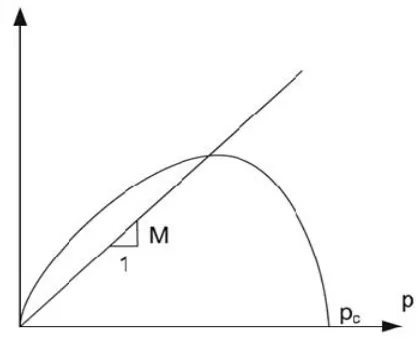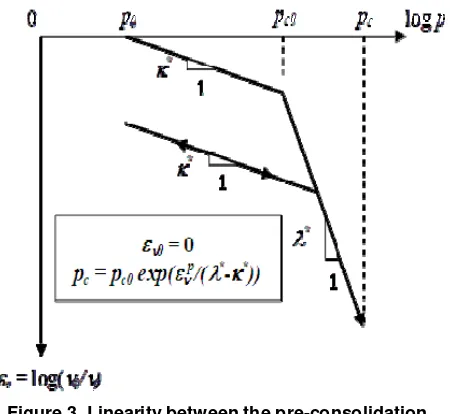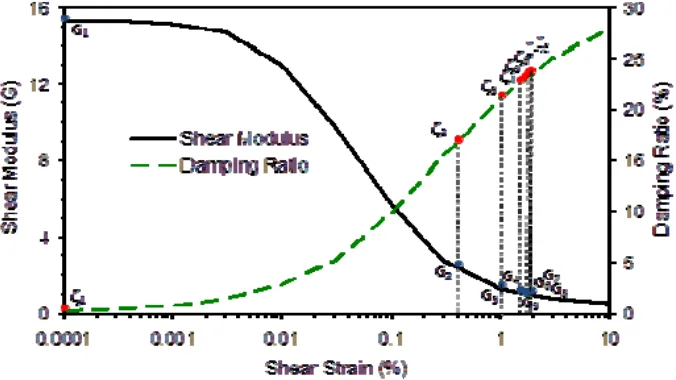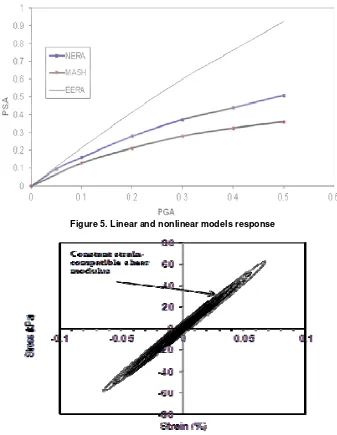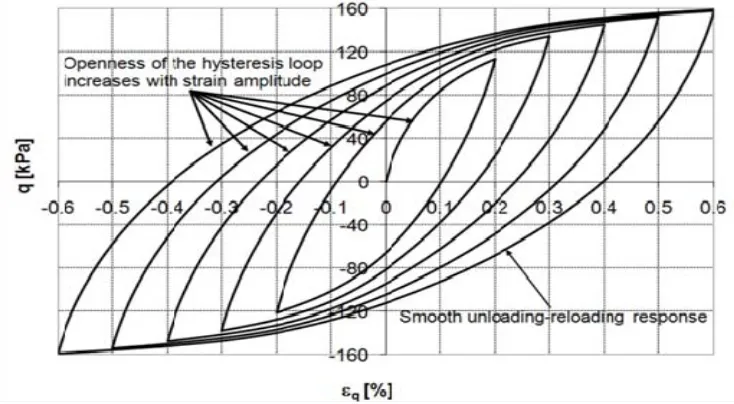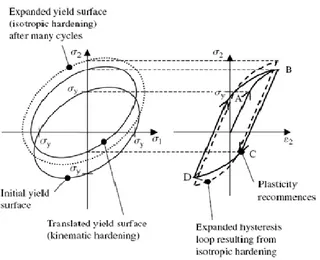Vol. 18 No. 3 Desember 2011 Abstract
It was known that soil behavior is dependent upon the history of loading and exhibits hardening behavior when deformed plastically. This paper presents a formulation of mixed hardening multisurface hyperplasticity model with stiffness factors of the kinematic hardening of the yield surfaces proportional to the pre-consolidation pressure to represent the history of loading. Formulation is emphasized for describing the cyclic loading behavior of clay soils. The advantages of this approach are that it can reproduce smooth transitions from elastic to plastic behavior and allows the stress-reversal history to be memorized by the internal variable function. The Modified Cam Clay yield function is selected as a key model to simulate the stress-strain response. The incremental stress–strain response is calculated based on a rate-dependent formulation. Finally, this paper describes the importance of development of the formulated soil model to improve current constitutive models for evaluating the effects of local soil conditions on earthquake ground response analysis. Further results of numerical implementation and simulations and also model verification employing the proposed mathematical model formulation will be reported in a future publication.
Keywords: Hyperplasticity, mixed hardening, pre-consolidation pressure, ground response analysis. Abstract
Telah diketahui bahwa perilaku tanah akan tergantung dari sejarah pembebanannya dan juga memperlihatkan perilaku hardening apabila tanah mengalami deformasi secara plastik. Tulisan ini menyajikan sebuah formulasi model tanah mixed hardening multisurface hyperplasticity dengan faktor kekakuan kinematik hardening proporsional terhadap tekanan pra-konsolidasi guna merepresentasikan sejarah pembebanan yang terjadi pada tanah. Formulasi ditekankan untuk mendeskripsikan perilaku pembebanan siklik pada tanah lempung. Kelebihan dari pendekatan model hyperplasticity ini adalah dapat menghasilkan transisi dari perilaku elastik ke plastik secara smooth serta mampu “mengingat” sejarah perubahan tegangan yang terjadi pada tanah dengan menggunakan fungsi variabel internal. Fungsi leleh Modified Cam Clay dipilih sebagai model utama untuk mensimulasikan respons tegangan-regangan. Selanjutnya, respons tegangan-regangan dihitung berdasarkan sebuah formulasi rate-dependent. Terakhir, tulisan ini mendeskripsikan pentingnya pengembangan model ini guna memperbaiki analisis respons tanah akibat gempa. Hasil-hasil lebih lanjut berupa implementasi dan simulasi numerik serta juga verifikasi model yang diusulkan akan disajikan dalam publikasi berikutnya.
Kata-kata Kunci: Hyperplasticity, mixed hardening, tekanan pra-konsolidasi, analisis respons tanah akibat gempa.
Development of Pre-consolidation Pressure Dependence of Mixed Hardening
Multisurface Hyperplasticity Model for Better Prediction of
Earthquakes Ground Response Analysis
Part I: Model Formulation
Dedi Apriadi
Department of Civil Engineering, Institut Teknologi Bandung, Jl. Ganesa 10 Bandung 40132 E-mail: [email protected]
Halida Yunita
Civil Engineering Department, Syiah Kuala University, Darussalam, Banda Aceh, NAD E-mail: [email protected]
Suched Likitlersuang
Department of Civil Engineering, Chulalongkorn University, Pathumwan, Bangkok 10100, Thailand E-mail: [email protected]
Thirapong Pipatpongsa
Global Scientific Information and Computing Center, Tokyo Institute of Technology Meguro-ku, Tokyo 152-8550, Japan, E-mail: [email protected]
228 Jurnal Teknik Sipil
1. Introduction
In modeling geomaterials, it is clear that multisurface models are able to fit the non-linear behavior more accurately across a wide range of strain amplitude. Within the framework of “continuous hyperplasticity”, it is also possible to generalize a multisurface model into an infinite number of yield surfaces.
Further, it is well-known that soil behavior is dependent upon the history of loading and exhibits hardening behavior when deformed plastically. In the early developments of critical state soil models (Roscoe and Burland, 1968); Schofield and Wroth, 1968) the history of loading that represented by pre-consolidation pressure is taken as a function of the void ratio to describe the size of the yield surface during unloading-reloading cycles. As for the size of the yield surface, another more recent suggestion that is valid from both dimensional and thermo-mechanical considerations (Hashiguchi, 1974; Butterfield, 1979; Collins and Kelly, 2002) is to take the pre-consolidation pressure as a function of the plastic volumetric strain rather than the void ratio. Moreover, various cyclic constitutive models have been proposed to date which can be classified into three classes: equivalent linear models (Schnabel et al., 1972; Bardet et al., 2000), cyclic nonlinear models (Streeter et al., 1973; Joyner et al., 1977; Lee and Finn, 1978; Martin and Seed, 1978; and Pyke, 1985) and advanced constitutive models based on the idea of isotropic hardening (Hashiguchi and Ueno, 1977; Hashiguchi, 1989) and kinematic hardening (Mroz, 1967; Iwan, 1967; Dafalias and Popov, 1975; Prevost, 1989; Bardet and Tobita, 2001) for evaluating the effects of local soil conditions on ground response during earthquakes.
Apriadi (2009a) and Apriadi et. al. (2009b) employed a non-linear continuous hyperplasticty kinematic hardening MCC model by extending the work of Likit-lersuang (LikitLikit-lersuang, 2003; LikitLikit-lersuang & Houls-by, 2006). In this model, the stiffness factors of the kinematic hardening of the yield surfaces proportional to the current pressure. Several model features of this model for describing cyclic behavior of soils such as irreversible unloading-reloading response, a hysteresis loop with accumulation shear strain and smooth transition of stiffness during unloading-reloading cycles have been presented. It is clearly shown that the dominant hardening processes such that the Bauschinger effect can be represented very well. Moreover, the developed model can also describe a non -linear behavior of soils more accurately across a wide range of strain amplitude. However, over (normally) quite large numbers of cycles the soils exhibit a combined isotropic and kinematic hardening or mixed hardening behavior (Dunne and Petrinic, 2005).
The objective of this work is to formulate a mixed hardening multisurface hyperplasticity model with stiffness factors of the kinematic hardening of the yield surfaces proportional to the pre-consolidation pressure rather than the current pressure. We initially describe some definitions of pre-consolidation pressure and continue with a formulation of the model in general stress conditions rather than triaxial stress conditions, followed by an explanation of the recent constitutive modeling in ground response analysis. Finally remarks are made on the features of the proposed model. This study is expected to contribute for improvement of load-deformation prediction in earthquake ground response analysis.
2. Pre-consolidation Pressure in Stress
Space
In critical state soil mechanics, the pre-consolidation pressure describes the asymptotic behavior of the model under isotropic (q = 0) normal compression conditions (p = pc) using some kinematic variables as
shown in Figure 1.
In the original critical state models Roscoe and Burland (1968); and Schofield and Wroth (1968) proposed the expression for the pre-consolidation pressure by:
where pr is a reference pressure, l is specific volume
at the reference pressure and is slope of normal compression line in : log p. The pre-consolidation pressure was expressed purely using the specific volume = 1+e (with e being the void ratio). In this model the void ratio related to the logarithm of the pressure and the size of yield surface is expressed using the void ratio as shown in Figure 2.
Figure 1. Definition of pre-consolidation pressure in typical yield surface projection in stress-space
(Einav and Carter, 2007)
Vol. 18 No. 3 Desember 2011 Figure 2. Original definition of pre-consolidation
pressure (Einav and Carter, 2007)
Another more recent suggestion, which is based from both dimensional and thermo-mechanical considera-tions (Hashiguchi, 1974; Butterfield, 1979; Collins and Kelly, 2002) is to express linearity between the pre-consolidation pressure and the void ratio in log–log space, i.e., a linear relation between log(pc) and log(),
also the size of yield surface is expressed using the pre-consolidation pressure as shown in Figure 3.
In this definition, the expression for the pre-consolidation pressure is expressed using plastic volu-metric strain evp by:
where Pc0 is initial pre-consolidation pressure, * is
slope of normal compression line in log () : log (p) and k* is slope of unloading-reloading line in log (): log (p).
Figure 3. Linearity between the pre-consolidation pressure and the void ratio in log–log space
(Einav and Carter, 2007)
Two definitions in Equation (1) and Equation (2) are quite significant. In the first definition, the specific volume at the reference pressure, λ is defined as the reference kinematic configuration which is unique for a given soil while in the second definition this parame-ter is represented by the initial pre-consolidation pressure, pc0 which is dependent upon the history of
loading.
3. Mixed Hardening Modified Cam Clay
Model
3.1 Sign convention
The standard soil mechanics sign convention of com-pressive stresses and strains positive is used through-out this paper, and all stresses are effective. The fol-lowing notation is adopted: ij is the effective Cauchy
stress tensor; ij is small-strain tensor; and ij is
Kron-ecker’s delta (ij = 1 if i = j, ij = 0 if i≠j where i, j Î
{1,2,3}).
component of the effective stress tensor. The corre-sponding strain invariants are
is a deviatoric component of the strain tensor. Similar-ly, generalized stress invariants are
is a deviatoric component of the effective generalised stress tensor. The corresponding internal variable invariants are
is deviatoric component of the internal variable tensor.
3.2 Model formulation
Under the hyperplasticity framework (Houlsby and Puzrin, 2006), a non-linear continuous hyperplasticity mixed hardening Modified Cam Clay (MCC) model is formulated to the Gibbs free energy by considering pre-consolidation pressure dependency in Equation (2) and non-linear elastic moduli at small-strain
The stress invariants are
230 Jurnal Teknik Sipil
k, g, and n are dimensionless material constant calibrat-ed from elastic stress-strain relation at small-strain lev-el. Atmospheric pressure 1 atm (approximately 100 kPa) is defined for pr as a reference pressure. Pc0= c0kk/3 is an initial pre-consolidation pressure, * is slope
of normal compression line in log () : log (p) and k* is slope of unloading-reloading line in log () : log (p). aij
is total plastic strain tensor. Integration of differential hardening energy is evaluated in terms of internal coor-dinate which is in range of 0 to 1.
which can be integrated to obtain ij using Equation
(4). It is important noted that all variables with “^” (hat) throughout this paper are referred to as internal variable functions of .
functions corresponding to isotropic and deviatoric hardening responses as expressed in Equations (5) and (6).
where a is a material hardening constant.
In the hyper plasticity framework, total strain compo-nents are considered as conjugate variables of stresses which are derived from the Gibbs energy function. From Equation (3), the strains ij can be obtained via
differentiation with stresses ij as shown in Equation
(7).
However, the Gibbs energy function expressed in Equation (3) and the strain components derived in
(1 )
stress variable for convenience.
ˆ
ij is kinematic internal variable tensor function of Equations (7) can only produce a constant modulus (n = 0) or power function of pressure dependent modu-lus (0 < n < 1). For linear pressure dependent modulus (n = 1) these equations will be replaced by Equations (8) and (9).
The second derivatives of Gibbs free energy are derived in Box 1. This form is applicable to 0 ≤n≤ 1. Further, the yield function in term of generalized stress variables is defined:
where M is a frictional critical state parameter (Roscoe and Burland, 1968) which is the value that stress ratio q/p attains at critical state,
with respect to generalised stress variables (Houlsby and Puzrin, 2006):
ˆ
are generalized stresses. When the stress is inside the
yield surface
y
ˆ
0
, materials behave elastically, butthey behave plastically when the yield surface is active
From Equation (3), it follows that ( ).
The evolution rule of kinematic internal variable functions
is derived from the derivatives of flow potential w
Vol. 18 No. 3 Desember 2011
Box 1: Second derivatives of Gibbs free energy
One may associate this kind of evolution rule to the flow rule used in classical plasticity. The flow potential w is defined based on elasto-viscoplastic theory (see for detail Zienkiewicz and Cormeau, 1974) in relation
where is the artificial viscosity coefficient in unit of kPa.s [SI units]. It is imposed on unity for rate-dependent calculation (Griffiths, 1980) while the operator are Macaulay brackets which define
However, we can actually define as a true viscosity coefficient to incorporate rate-dependent behaviour of soil such as creep problems.
According to Equations (7) and (9), total strain com-ponents are derived as function of and By flow rule, rate of change of total strain components can be written by the following equations.
By using Equations (12) and (13), the rate form of stress-strain relationship obtained in Equation (14) can be expressed.
The derivative of flow potential w in Equation (13) is shown in Equation (16).
to the yield function
y
ˆ
as shown in Equation (13).3.3 Model parameter determination
Compared to non-linear kinematic hardening MCC model (Apriadi et al., 2009), the mixed hardening MCC model has eight number of parameters, consisting of three dimensionless material constant parameters (g, k, and n), three parameters for critical state (M, l*, k*), and two kinematic hardening parameter (a, Pc0). These parameters are obtained
through processes of parameter calibration from the experiment results (see Apriadi et al. (2009) for details).
4. Constitutive
Modeling
in
Ground
Response Analysis
4.1 Recent cyclic constitutive models
Several methods for evaluating the effects of local soil conditions on ground response during earthquakes are presently available. Most of these methods are based on the assumption that the main responses in a soil deposit are caused by the one-dimensionally upward propagation of shear wave from the underlying bed formation (Schnabel et. al, 1972). Computer program developed for this analysis are generally based on either the solution of the wave equation or on a lumped mass simulation. Some of these programs are based on soil constitutive modeling and use either finite different or finite element analysis as shown in Table 1. The soil models which are described in Table 1 can be classified into three classes: equivalent linear models, cyclic nonlinear models and advanced constitutive models (Kramer, 1986).
232 Jurnal Teknik Sipil
Program Soil Model Reference
SHAKE Equivalent linear Schnabel et al. (1972)
EERA Equivalent linear Bardet et al. (2000) CHARSOIL Ramberg-Osgood Streeter et al.
(1973)
NONLI3 Iwan-type Joyner et al. (1975, 1977)
DESRA-2 Hyperbolic Lee and Finn (1978) MASH
Martin-Davidenkov
Martin and Seed (1978)
TESS1 HDCP Pyke (1985)
NERA Iwan-Mroz Bardet and Tobita (2001)
DYNA1D Nested Yield Surface
Prevost (1989)
Table 1. Constitutive modeling for one-dimensional ground response analysis
Equivalent linear models treat soils as a linear viscoe-lastic material. It involves the iterative use of strain-compatible soil properties in either a frequency-domain or time-domain-based analysis to account for the non-linearity of the shear modulus and damping ratios is shown in Figure 4.
An our comparative study on linear and nonlinear models site response analysis using EERA (equivalent linear model) and NERA & MASH (nonlinear models) shows that although the equivalent linear approach is computationally more efficient, the inherent linearity of this model can cause a high level of amplification as shown in Figure 5. This figure plots response between Peak Ground Acceleration at baserock (PGA) and Peak Surface Acceleration (PSA). Also, the strain-compatible shear modulus remain constant throughout the duration of an earthquake when the strain induced in the soils are small or large as shown in Figure 6.
Figure 4. Strain-compatible shear modulus and damping iteration
Moreover, the use of an effective shear strain in an equivalent linear analysis can cause an over-softened and over-damped system (the peak shear strain is much larger than the remainder of the shear strain), or to an under-softened and under-damped system (the shear strain amplitude is nearly uniform) to occur (Kramer, 1986).
Cyclic non-linear models such as the hyperbolic mod-el, Ramberg-Osgood modmod-el, Hardin-Drnevich-Cundall -Pyke (HDCP) model, Martin-Davidenkov model and Iwan-type model represent the non-linear, inelastic behavior of soils using a non-linear backbone curve and a series of ad-hoc rules that govern unloading-reloading behavior. Although this model have some advantages over equivalent linear such the ability to represent the development of permanent strains as shown in Figure 7, but it inherently incorporates the hysteretic nature of damping and the strain-dependence of the shear modulus and damping ratio.
Vol. 18 No. 3 Desember 2011 Figure 5. Linear and nonlinear models response
Figure 6. Linear stiffness responses in equivalent linear model
Nonlinear and
inelastic behavior
234 Jurnal Teknik Sipil
4.2 Proposed model features
Apriadi (2009a) and Apriadi et al. (2009b) have shown several model features of non-linear continuous hyper-plasticity kinematic hardening MCC model in modeling cyclic behavior of soils such as irreversible unloading-reloading response, a hysteresis loop with accumulation shear strain and smooth transition of stiffness during unloading-reloading cycles as shown in Figures 7 and 8. It is clearly shown that the dominant hardening processes such that the Bauschinger effect can be represented very well. Moreover, the developed model can describe a non-linear behavior of soils more accurately across a wide range of strain amplitude.
However, over (normally) quite large numbers of cycles, the material also hardens isotropically such that the peak tension and compression stresses in a given cycle increase from one cycle to the next until satura-tion is achieved (Dunne and Petrinic, 2005). Such a process is represented schematically in Figure 9. Starting from the point of zero stress and strain, the material is subjected to the strain and then the stress increases until yield is achieved at point A, and the material kinematically hardens leading to the translation of the yield surface.
Dunne and Petrinic (2005) stated that once the peak strain is achieved, the strain reversal occurs so that the material becomes elastic at point B. Elastic deformation continues until the load point reaches the yield surface again at point C where plasticity recommences until the next strain reversal at point D. The yield surface is translated again because of the kinematic hardening. The stress–strain loop BCDB produced in this way is called a hysteresis loop. If, in addition to the kinematic hardening, the material also isotropically hardens, then superimposed upon the translation of the yield surface is a progressive expansion, shown by the broken line hysteresis loop in Figure 7. This process, by which the
Figure 7. Cyclic undrained stress-strain curves (Apriadi et al., 2009)
peak stress and strain in a hysteresis loop increase, due to isotropic hardening, is often called cyclic hardening, as it often occurs from cycle to cycle over many cycles. Kinematic hardening, on the other hand, occurs within each cycle.
This fact supports the importance of development of the mixed hardening MCC model in accordance to improve current constitutive models for evaluating the effects of local soil conditions on earthquake ground response analysis.
4. Conclusions
Based on the our current work on development of hyperplasticity-based model for predicting earthquake ground response analysis, some important conclusions can be drawn, i.e.:
1. Formulation of a non-linear mixed hardening multi-surface hyperplasticity model considering a stiff-ness factors of the kinematic hardening of the yield surfaces proportional to the pre-consolidation pressure have been presented.
2. Some definitions of pre-consolidation pressure and recent constitutive modeling in ground response analysis have been also explained.
3. Remarks are made on the features of the proposed model such as irreversible unloading-reloading response, a hysteresis loop with accumu-lation shear strain and smooth transition of stiffness during unloading-reloading cycles.
4. Results of numerical implementation, simulations and model verification employing the proposed-mathematical model formulation will be reported in a future publication.
Vol. 18 No. 3 Desember 2011 Figure 8. Irreversible cyclic undrained stress-strain curves (Apriadi et al., 2009)
236 Jurnal Teknik Sipil
5. Acknowledgements
This work was supported by AUN/SEED-Net JICA. The authors would like to express its sincere apprecia-tion for the grant.
References
Apriadi, D., 2009, Development and Numerical Imple-mentation of Thermodynamics-based Soil Mod-el, Ph.D. Thesis, Chulalongkorn University.
Apriadi, D., Likitlersuang, S., Pipatpongsa, T. and Ohta, H.. 2009, On The Numerical Implementa-tion of Hyperplasticity Non-Linear Kinematic Hardening Modified Cam Clay Model, The IES Journal Part A: Civil & Structural Engineering, Vol. 2, No. 3, pp. 187-201.
Bardet, J.P., Ichii, K., and Lin, C.H., 2000. EERA, A Computer Program for Equivalent linear Earthquake site Response Analysis of Layered Soils Deposits, Los Angeles: University of Southern California.
Bardet, J.P., and Tobita, T., 2001, NERA, A Computer Program for Nonlinear Earthquake Site Response Analyses of Layered Soil Deposits, Los Angeles: University of Southern California.
Butterfield, R., 1979, A Natural Compression Law for Soils (an advance on e-log p’), Géotechnique 29, No. 4, 469–480.
Collins, I.F., Kelly, P.A., 2002, A Thermomechanical Analysis of A Family of Soil Models. Géotechnique 52, No. 7, 507–518.
Dafalias, Y.F., Popov, E.P., 1975, A Model of Nonlin-early Hardening Materials for Complex Load-ing, Acta Meek 23, 173–192.
Dunne, F., and Petrinic, N., 2005, Introduction to Computational Plasticity, London : Oxford University Press.
Einav, I. and Carter, J.P., 2007, On Convexity, Normality, Pre-consolidation Pressure, and Singularities in Modeling of Granular Materials, Granular Matter 9, 87–96.
Griffiths, D.V., 1980, Finite Element Analyses of Walls, Footings and Slopes, Ph.D. Thesis, University of Manchester.
Hashiguchi, K., 1974, Isotropic Hardening Theory of Granular Media. Proc. JSCE 227, 45–60.
Hashiguchi, K., Ueno, M., 1977, Elastoplastic Consti-tutive Laws of Granular Materials, ConstiConsti-tutive Equations of Soils. Tokyo, In: Murayama, S., Schofield, A.N. (eds.) Proc. 9th Int. Conf. Soil. Mech. Found. Eng., Spec. Ses. 9, JSSMFE, pp. 73–82.
Hashiguchi, K., 1989, Subloading Surface Model in Unconventional Plasticity. Int. J. Solids Structures 25, 917–945.
Houlsby, G.T., Amorosi, A. and Rojas, E., 2005, Elastic Moduli of Soils Dependent on Pressure: A Hyperelastic Formulation, Géotechnique, Vol. 55, No. 5, pp 383 – 392.
Houlsby, G.T., and Puzrin, A.M., 2006, Principles of Hyperplasticity: An Approach to Plasticity Theory Based on Thermodynamics Principles, London : Springer-Verlag, London Limited.
Iwan, W.D., 1967, On A Class of Models for The Yielding Behavior of Continuous and Composite Systems, J. Appl. Meek. (ASME) 34, 612–617.
Joyner, W.B., 1977, NONLI3: A Fortran Program for Calculating Nonlinear Ground Response, Open File Report 77-761, California: U.S. Geological Survey, Menlo Park.
Kramer, S.L., 1996, Geotechnical Earthquake Engineering, New Jersey: Prentice Hall.
Lee, M.K.W., and Finn, W.D.L., 1978, DESRA-2: Dynamic Effective Stress Response Analysis of Soil Deposits with Energy Transmitting Boundary Including Assessment of Liquefaction Potential, Vancouver: Soil Mechanics Series, No. 38, University of British Columbia.
Likitlersuang, S., and Houlsby, G.T., 2006, Development of Hyperplasticity Model for Soil Mechanics, International Journal for Numerical and Analytical Method in Geomechanics, No. 30, pp 229 – 254.
Likitlersuang, S., 2003, A Hyperplasticity Model for Clay Behaviour: An Application to Bangkok Clay, Oxford University: D.Phil. Thesis.
Martin, P.P., and Seed, H.B., 1978, MASH: A Computer Program for The Nonlinear
Vol. 18 No. 3 Desember 2011 Mroz, Z., 1967, On The Description of Anisotropic
Workhardening, J. Mech. Phys. Solids 15, 163– 175.
Pyke, R.M., 1985, TESS1: A Computer Program or Nonlinear Ground Response Analysis, Cal-ifornia: User Manual, TAGA Engineering Soft-ware Services, Lafayette.
Prevost, J.H., 1989, DYNA1D: A Computer Program for Nonlinear Seismic Site Response Analysis-Technical Documentation, Multidisciplinary Center for Earthquake Engineering Research, Report NCEER-89-0025.
Roscoe, K.H., and Burland, J.B., 1968, On The Generalised Stress-Strain Behaviour of Wet Clay, Engineering Plasticity, Cambridge University Press, pp 535-610.
Schnabel, P.B., Lysmer, J., and Seed, H.B., 1972, SHAKE: A Computer Program for Earthquake Response Analysis of Horizontally Layered Sites, University of California, Berkeley: Report No. UCB/EERC-28 -72/12, Earthquake Engineering Research Center, December, 102p.
Schofield, A.N., and Wroth, C.P., 1968, Critical State Soil Mechanics, London: McGraw Hill.
Streeter, V.L., Wylie, E.B., and Richart, F.E., 1973, Soil Motion Computations By Characteristics Methods, San Francisco: Proc. ASCE National Structural Engineering Conference.
